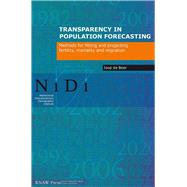Transparency in Population Forecasting

Transparency in Population Forecasting
- ISBN 13:
9789069846378
- ISBN 10:
9069846373
- Format: Paperback
- Copyright: 08/15/2013
- Publisher: Amsterdam Univ Pr
Rent
Sorry, this item is currently unavailable.
Note: Supplemental materials are not guaranteed with Rental or Used book purchases.
Extend or Purchase Your Rental at Any Time
Need to keep your rental past your due date? At any time before your due date you can extend or purchase your rental through your account.
Summary
At the moment that a population forecast for the long run is published the user cannot decide whether the forecast will be accurate. The user can only judge the methods used and assumptions made by the forecaster. This requires transparency of forecasts. The forecaster should make his or her choices of methods and assumptions and the arguments behind these choices explicit. Population projections are based on assumptions about future changes in fertility, mortality and migration. This book describes methods that can be used for making these assumptions and discusses which choices have to be made by the forecaster. Forecasts should be based on good data. Data on international migration tend to be less reliable than data on fertility and mortality. Statistics on international migration can be improved on the basis of a comparison of data from different countries. If emigration statistics of a sending country are compared with the corresponding immigration statistics of receiving countries, one can estimate to what extent emigration statistics may underestimate the true migration flows. Different types of migrants, such as labour migrants, family migrants and asylum seekers, react differently to economic, political and cultural developments. Therefore for making assumptions about future Changes in migration it is useful to distinguish immigration and emigration by type of migrant. For making assumptions about future changes in fertility it is useful to compare the current pattern of fertility in different countries with that in one 'forerunner' country. In many countries the average age at childbearing can be expected to increase, but it will make a difference whether this is caused by a decrease in the fertility of very young women, an increase in fertility around the 'peak' age 30, or an increase in fertility of women around age 40. Therefore the forecaster should make assumptions about separate age-specific fertility rates rather than about the total fertility rate and mean age at childbearing only. Japanese women have the highest life expectancy in the world. A linear projection shows that life expectancy of Japanese women may increase to 100 years over the next 50 years. For each European country we can estimate to what extent death probabilities will move in the direction of the low Japanese levels. Estimating an average trend across European countries provides a more stable projection than estimating a trend for each country separately. For Northern, Western and Southern European countries life expectancy of women may be expected to increase to around 90 years in 2060.






